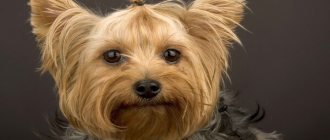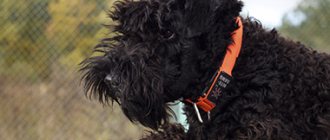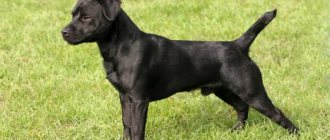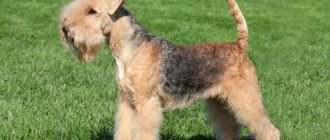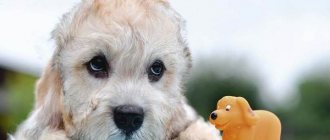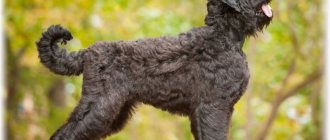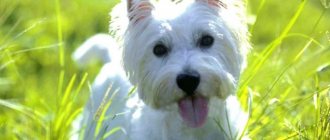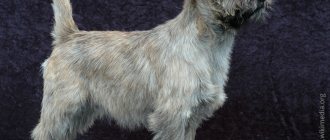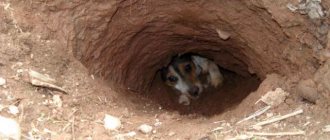Description of the breed - history
English toy terriers began to be imported en masse to Russia in the mid-19th century. They gained unprecedented popularity among the aristocratic community and became the favorite breed of wealthy ladies. But then the revolution broke out, elite dogs began to wander in search of food and interbreed with mongrels. Only in the middle of the 20th century did breeders begin to restore ornamental breeds, which included toy terriers. Unfortunately, it was forbidden to export purebred dogs from England, so local scientists had to restore the population, using middle-class individuals as a basis. The result was a Russian version of the breed, far from the standard accepted abroad.
Until 1957, only the smooth-haired variety of terrier was known, until one day an ordinary pair of parents gave birth to a baby with long hair. The puppy was considered defective and sent to the kennel of the Moscow breeder Evgenia Fominichna Zharova. She appreciated the baby's potential and began selecting long-haired dogs. After a few years, the nursery had a stable population of fringed toy cats. The new variety of terriers had a number of serious differences from the original, so Zharova began working on its official recognition. In 1966, the longhaired subspecies received an approved standard and became a full-fledged breed.
After the fall of the Iron Curtain, the massive import of decorative dogs began, so toy terriers sharply lost ground. The breed had to be hastily restored; already in the nineties, the cost of babies increased rapidly. Toy terrier kennels were provided with orders for years to come.
Character
This breed owes its popularity not only to its appearance, but also to its friendly disposition. The toy is social and needs the approval of the owner. Despite its small size, the dog has a strong, fearless character. She will react to any suspicious sound and will rush to her owner’s defense without hesitation.
Toy terriers are suitable for people of all ages. They love children and pensioners equally. This breed has a sharp mind and easily remembers commands. Dogs try to be close to their owner and get very bored in his absence. Toys love to be the center of attention and often resort to cunning to earn it. They do not have a tendency to dominate, but they can be stubborn and capricious.
This breed needs training and education. If the owner does not set boundaries for what is permitted, the dog will quickly understand this. Therefore, it is recommended to correct the puppy’s behavior from the first days of life.
Some terriers are prone to aggression and do not like children. Professional training will help suppress such impulses. However, you should not have a toy terrier in families with small children: they can accidentally cause serious injury to the dog.
History of the origin of the breed
There is no reliable information about the origin of the breed. According to the official version, it originated on the basis of the old black and tan terrier from the short Manchester terriers. In some old paintings (16-17 centuries) you can see very similar dogs. The small black and tan terrier became a popular city dog breed in the late 19th century.
What does a toy terrier look like?
For your information! Pinscher is a group of dog breeds that were originally bred to catch rats. But one day one of the representatives of British terriers took part in an exhibition. Subsequently, dogs of this group migrated to other countries.
Breed conservation
Selection work with two weight categories of this breed continued until 1920. Later they were officially divided: the larger Manchester Terrier and the miniature Black and Tan Terrier.
In North America, the two breeds existed separately, but after a decline in numbers, the American Kennel Club decided to merge, creating two varieties. This forced measure led to huge confusion with names.
The goal of further breeding was to create a kind and affectionate pet, but the experiments almost led to complete extinction. The toy terrier was saved, but his health was compromised.
Today they are ideal little companions, gentle and loving, elegant and graceful, capable of the most tender feelings.
Note! Today the British Toy Terrier is included in the list of endangered breeds. The Kennel Club is doing everything possible and making great efforts to increase the popularity of the species and create a viable gene pool.
Types - breed standard
Russian Toy Terriers are the smallest representatives of the species. They belong to the mini category and are divided into two types:
- Smooth-haired. The coat is short and lies tightly to the dog's body. The hair structure is smooth. There is no undercoat.
- Long-haired. The coat is moderately long, 3-5 cm. It can be straight or wavy, the main thing is that the pile does not hide the outline of the body. The hair on the paws is longer, and on the ears it forms characteristic tufts.
The smooth-haired variety was bred more than a hundred years ago in England, the long-haired variety was bred in the 50s of the 20th century in Moscow.
Breed standard:
- Dimensions of an adult dog: male height - 20-30 cm, female - 21-28 cm.
- Weight of an adult dog: up to 3 kg.
- The body is oval, dry, with a pronounced transition to the withers.
- The tail is usually docked (undocked is acceptable).
- The chest is of moderate width, set deep.
- The skull is rounded, with a characteristic convex forehead. A clear transition from the forehead to the nose.
- The muzzle is sharp at the end, elongated.
- The nose is neat, small, pigmented depending on the color.
- The jaws are tightly clenched, with a scissor bite. The lips fit well to the teeth.
- The eyes are convex, quite large, dark in color, oval.
- The ears are set high, triangular in shape, erect.
- The neck is moderately long, with a smooth bend.
- The stomach is slender and lean.
- The limbs are thin-boned and straight. Paws are oval with closely pressed toes.
The Russian Toy Terrier is a graceful, well-built animal. His movements are confident and free.
Colors
The primary colors of the terrier are black and chocolate and tan. Selection work has diversified this palette. Now the dogs are colored tan blue, as well as red with splashes of black and brown. The shade should be pure and moderately saturated.
A violation of the standard is:
- white wool color;
- White spots;
- black;
- brown;
- blue;
- too saturated and excessively large scorch marks;
- zonal color.
Close attention is paid to the condition of the coat. A show terrier cannot have sparse, poorly growing hair. At the same time, too long and curly hair is considered a defect.
Red Yorkshire Terrier
This is a breed of decorative dogs. In appearance and character it is much closer to the Russian Toy Terrier than to the Staffordshire variety. The breed was developed in England, and the name comes from the county in which it originated. Today, the Yorkie is one of the most popular dog breeds in the world. The dog has long hair without undercoat, so during winter walks it should be warmed. The animal's fur is very similar to human hair.
The small size of a dog does not at all deprive it of the true character of all terriers - activity, courage and curiosity. Such dogs are peaceful and friendly, they become strongly attached to their owner. It is believed that this breed most of all needs human attention. The owners of these dogs claim that their pets are ready to spend the whole day with a person.
These dogs love to spend time actively. They are also keen hunters and can hunt beetles and mice. In some cases, they eat their prey. This should be monitored closely, as such a meal can cause serious stomach upset.
To summarize, it should be said that the red toy terrier is a wonderful breed of dog. The animal will become the best friend for all family members. But owners of this breed should remember to raise their little miracle.
Maintenance and care
Toys are an indoor breed. Their coat is not designed to last long on the street. The best way to protect your pet from colds is to buy him several sets of clothes. It should correspond to the time of year and not restrict the animal’s movements. In winter you will need a warm overall with a hood, in the fall - a light jacket, sweater and raincoat.
In summer, you should not put a lot of clothes on your dog: this will disrupt heat exchange and cause overheating.
Hygiene is the key to the health and longevity of any animal. The terrier's ears are examined at least once a month. They are checked for dirt, scratches and cracks, as well as the presence of an unpleasant odor. The ears are treated with a cotton pad or swab dipped in warm water. In addition, you can use special cleaning lotions. Toy terriers have sensitive ears, so it is strictly forbidden to touch the recess in the ears. Only the outer part needs to be cleaned. You should also not use cotton swabs: they can damage your hearing.
Teeth and oral cavity require special attention. If at the age of five months the loss of baby teeth is difficult, you need to show the baby to a veterinarian: they may have to be removed under anesthesia. Otherwise, an incorrect bite will form. Brush your teeth with dog paste once a week. The puppy is accustomed to the procedure from early childhood.
It is not recommended to overuse games with tugging objects: this can lead to malocclusion.
Terriers are bathed no more than once every 5 or 7 months. The peculiarity of this breed is dry, prone to irritation, skin. If your dog has had vaccinations or surgery, he should not get wet for two weeks. Toys are bathed in warm, clean water using special shampoos and conditioners. Human cosmetics are not suitable for sensitive skin of dogs. Its use causes dandruff and allergies.
Upon completion of the procedure, the wool can be dried with a hairdryer. To do this, choose the most gentle mode. Smooth-haired terriers are brushed with a rubber mitt once a week. Long-haired dogs need to be brushed daily. A fine-tooth comb or comb is suitable for this. Show Toy Terriers require regular grooming. For pet-class pets, it will be enough to thin out the hair between the toes. The pet's nails are trimmed monthly. If a toy walks outside a lot, they sharpen themselves.
Mini content features
Toy terriers are quite unpretentious, but they require certain conditions. Features of keeping a dog:
- Toys do not need long walks and quickly get used to the tray. However, it is better to provide them with an outlet for energy and communication with their relatives. Otherwise, terriers may begin to damage furniture and behave aggressively.
- Reproduction of small breeds is always associated with great risk. For this reason, it is not recommended to carry out mating yourself. The wisest thing to do is to refuse breeding. It's not just the small size of the dog, but also genetic disorders.
- Mini Terriers are prone to damage and injury. They can get a broken paw if they fall even from a small height. Doors are no less dangerous for them. Toys are not recommended for families with small children. Excessive, careless petting can cause irreparable harm to a dog's health.
- This breed is known for its affection towards people. They make excellent companions and have a hard time with separation. Toys require a lot of attention and are not suitable for those who are rarely at home.
If the owner is ready for constant responsibility for the life and health of the pet, he will be able to provide him with complete care.
What to feed
The Toy Terrier can be fed with both natural and dry food. Natural feeding implies a varied and balanced menu. The Toy Terrier's daily diet should include vitamins, fiber, proteins and essential minerals.
The list of useful products includes:
- lean meat;
- fish (hake is best);
- offal;
- egg yolk;
- cereals: rice, buckwheat, rolled oats;
- vegetables: cucumbers, beets, carrots, zucchini, bell peppers;
- low-fat dairy products (cottage cheese, kefir or fermented baked milk);
- fruits: apples, apricots, bananas, peaches, pears.
The ratio of ingredients in the daily intake of homemade food:
- meat and offal -30-40%
- cereals - 30%;
- vegetables - 20%;
- fruits - 10%.
3 times a month the dog is offered an egg yolk and low-calorie fish. Fermented milk products are given rarely and in small quantities.
Milk is poorly digested by toy terriers and disrupts the functioning of the gastrointestinal tract.
Dogs are contraindicated:
- fat;
- sweet;
- flour;
- salty;
- roast;
- smoked;
- spicy;
- nuts (especially macadamia nuts).
Toy terriers love to beg for forbidden treats, so the puppy must be taught a diet from childhood. He must get used to receiving food on a schedule and in a certain quantity. In addition to the main menu, the toy terrier’s diet should include a complex of vitamins and minerals. It is selected by a veterinarian based on the parameters and health of the dog.
This breed is known for its sensitive gastrointestinal tract, so the owner will have to forget about buying cheap food. Premium and super premium class products are suitable for toy terriers. Economy brands use allergenic corn as a filler and do not skimp on taste and smell enhancers. Excess phosphorus, potassium, and calcium accumulate in the dog’s kidneys and cause urolithiasis.
Quality feeds include:
- Acana;
- Eagle Pack Holistic;
- Orijen;
- Hill's.
The packages of super premium products indicate the recommended feed to weight ratio.
When feeding dry food, the animal must have access to a bowl of fresh water.
Diseases
Russian Toy Terriers can be considered a fairly healthy breed. When properly maintained, their lifespan is 12-15 years. The list of pathologies may seem impressive, but the diseases listed are typical for many mini dogs:
- dislocation of the knee joints;
- cataract;
- retinal atrophy;
- difficulty changing teeth;
- Legg-Calvé-Perthes disease;
- hydrocephalus;
- hypoglycemia;
- atlantoaxial instability;
- pancreatitis;
- conjunctivitis.
If we compare Toychiks with representatives of other dwarf breeds, we can note their resistance to genetic diseases. This may be due to the short selection period and favorable heredity.
Red Staffordshire Terrier
The breed was bred in the USA. The name of the breed is often replaced by the word Amstaff. This breed of dog was developed by crossing a Smoot Terrier and a Bulldog. The dog is very different from the Russian Toy Terrier. The animal is strong and muscular, its appearance is quite menacing.
The color of this dog is uniform. The shade of red can range from yellow to red. With this color, the animal most often has dark brown eyes and a black nose.
The peculiarity of this breed is that the color of the animal can be practically any (black, red, fawn, seal). These dogs are very contradictory in character. They combine strength, courage, kindness and sensitivity, but at the same time they are not devoid of fearlessness, perseverance, and strength. Despite all this, they are very loyal to their owners.
The breed is highly trainable from a very early age. It is highly not recommended to chain such a dog - it will not withstand such a regime.
Mating and birth
The first mating is carried out after the dog's third heat. Early mating is dangerous for the health of the mother and offspring.
It is strictly forbidden to breed smooth-haired and long-haired terriers. Puppies will be considered mixed breed and will not be able to participate in breeding.
The best moment for mating is the fourteenth day from the start of estrus. In addition, it is necessary to observe the dog’s behavior: it will show its readiness. Toy terriers weighing up to 1.5 kg are not allowed for breeding. The ideal weight for conception is 1.8 kg. During pregnancy, the girl will eat more than usual. The owner’s task is to provide her with a complete and varied diet, as well as a complex of vitamins and minerals. During the gestation period, the dog should be regularly examined by a doctor.
Childbirth in Toy Terriers is often accompanied by complications, so the presence of a veterinarian is vital. His duties will include cutting the umbilical cord, drying the puppies, suctioning excess fluid from the nose and mouth, and resuscitating measures. Toy terrier puppies often die during childbirth, so they may need urgent help, which will not be easy to provide. Only veterinarians have the necessary medicines and equipment.
Training
Toy terriers are taught order from an early age. The dog should not beg for treats, go to the toilet in the wrong place and bark for no reason. The puppy is clearly shown what is required of him, and the result is reinforced with a treat. An adult Toy is trained differently: he is scolded for unfulfilled commands and praised for his successes.
Dogs should not be trained by shouting and punishment. They will hold a grudge and will not respond to orders.
In addition, it is useful to teach toys standard commands: fu, come to me, next to me, sit, lie down. To prevent your pet from showing aggression towards other people's dogs and people, it needs to be socialized in time. It is best to start this process after the first vaccinations.
